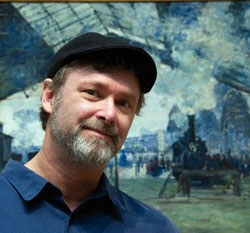Simanaitis Says
On cars, old, new and future; science & technology; vintage airplanes, computer flight simulation of them; Sherlockiana; our English language; travel; and other stuff
IMPRESSIONISM, SACRÉ BLEU AND CADMIUM-SULFIDE YELLOW
THIS IS triply a celebration of an era, a book review and a scientific tidbit. The era is the Belle Epoque, 1871 to the outbreak of World War I, when artists, many of them Paris-based, saw light and color in entirely new ways. Impressionists and Post-Impressionists included Camille Pissarro, Édouard Manet, Claude Monet, Pierre-Auguste Renoir, Paul Gauguin and Vincent Van Gogh. An earlier review at this website, of The Annotated Mona Lisa, put these times in perspective with other art movements.

Sacre Bleu: A Comedy d’Art, by Christopher Moore, William Morrow, 2012.
In the dazzling novel Sacré Bleu: A Comedy d’Art, another well-known Belle Epoque artist, Henri de Toulouse-Lautrec, is libertine pal and sidekick to Lucien Lessard, Christopher Moore’s baker/wanna-be artist, in their quest for the killer of Vincent Van Gogh. (Was his death really a suicide?)
In solving this, they also uncover the secret—and magic—of Sacré Bleu, a mysterious pigment peddled by The Colorman, the timeless tempter of the world’s great artists. There’s also The Colorman’s vamp companion who adds mystery, not to say amorous danger, through the ages.
Moore’s humor has been called “as ever, sweetly juvenile” by Kirkus Review. I’d call it an absolute hoot. I also recommend his Fluke: Or, I Know Why the Winged Whale Sings and Lamb: The Gospel According to Biff, Christ’s Childhood Pal and, one of my current pleasures, The Serpent of Venice, Moore’s comedic stitchup of Othello and The Merchant of Venice, with “The Cask of Amontillado” woven in for texture.
The blue of Sacré Bleu is its ultramarine hue associated with the cloak of the Virgin Mary. Historically, the pigment was derived from crushed lapis lazuli, one of many colors coming from precious and difficult-to-obtain sources. Purple, for instance, came from Syrian snails, its rarity accounting for the color’s association with royalty.
Which brings me to a tidbit of Belle Epoque color in Science, July 10, 2015, the weekly magazine of the American Association for the Advancement of Science.
According to the magazine’s “Why The Joy of Life has lost its shine,” when Henri Matisse first exhibited Le Bonheur de vivre at the Paris Salon des Indépendence in 1906, its shockingly bright colors caused quite a stir.
Over the years, however, the vividness had gone, even if the subject matter still gets our attention. In 2006, scientists identified that its bright yellow, a pigment of cadmium sulfide, was flaking and diminishing the painting’s vibrancy.
Now a new study reported in Applied Physics A describes the cause of this degradation. Researchers at the European Synchrotron in Grenoble, France, applied infrared microscopy and x-ray techniques of diffraction, absorption spectroscopy and fluorescence to tiny samples of the painting.
The culprit? Light. As described in Science, the water-insoluble cadmium-sulfide pigment is vulnerable to light-induced oxidation that turns it into water-soluble—and colorless—cadmium sulfate.
Many other masterpieces are at risk of fading because the pigment was widely used by other Impressionist and Post-Impressionist artists, including Vincent Van Gogh.
Where are The Colorman and his vamp when we need them? ds
© Dennis Simanaitis, SimanaitisSays.com, 2015



Interesting. And isn’t CdS a primary ingredient in camera light meters? It’s photo-resistive iirc.
So says Google, of one sort of light meter.